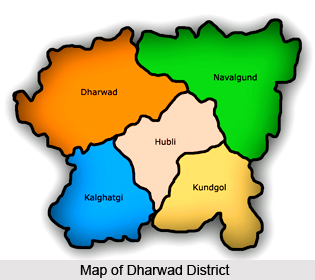 Dharwad district is situated in the Western sector of the northern half of Karnataka State. The District encompasses an area of 4263 Sq.Kms, and lies between the latitudinal parallels of 15 degrees 2 minutes and 15 degrees 51 minutes North and longitudes of 73 degrees 43 minutes and 75 degrees 35 minutes East. The district is bounded on the North by the Belgaum district, on the East by the district of Gadag District, on the South by the Haveri district and on the West by Uttara Kannada district. All these districts, which surround Dharwad district, belong to the state of Karnataka itself.
Dharwad district is situated in the Western sector of the northern half of Karnataka State. The District encompasses an area of 4263 Sq.Kms, and lies between the latitudinal parallels of 15 degrees 2 minutes and 15 degrees 51 minutes North and longitudes of 73 degrees 43 minutes and 75 degrees 35 minutes East. The district is bounded on the North by the Belgaum district, on the East by the district of Gadag District, on the South by the Haveri district and on the West by Uttara Kannada district. All these districts, which surround Dharwad district, belong to the state of Karnataka itself.
The District lies approximately about 800 metres above the sea level, which is why it enjoys a moderate and healthy climate. The District may be divided into 3 natural regions, viz., the Malnad, Semi-Malnad and Maidan. These regions, on an average, receive moderate to heavy rainfall and have dense vegetation. Kalghatagi and Alnavar area in Dharwad taluka in particular receive more rainfall than other talukas of the District. The mineral and forest wealth of the district is not too impressive.
The demographics of the place is such that the population forms quite a mix of cultures. The district is a place for people belonging to various religions like Hinduism, Islam, Jainism and Christianity. Hindus, in particular, are spread across rural and urban areas. The widely spoken language in the district is the Kannada language, while a thin population is found using languages like Urdu, Marathi, Hindi, Telugu, Gujarati and Malayalam.
Agriculture forms a major activity in this part of the district. Perhaps this can be explained by the fact that the region falls under the Tropical Region which is why it is widely affected by monsoons. In fact the economy itself is an agro-based economy. The main soil type found here is black soil which helps in raising crops like cotton, wheat, Ragi, Jowar and oilseeds. The red soil which is also found here is more suitable for paddy. Among these, the main kharif crops are cotton, chillies, sugarcane and groundnuts, and the main Rabi crops are jowar, wheat, rice etc. The prestigious University of Agricultural Sciences at Dharwad has discovered new species of cotton and chilies, which is the first of its kind in the world. Therefore other activities of economy, i.e., trade and commerce are completely dependent on agriculture. As monsoon is highly uncertain in nature and as there is no major irrigation project or any hydel power generating station in the district, there is high degree of dry-land farming.



















